* * *
One fine day in late May, rape flowers were in full bloom in Yokohama-machi, Aomori Prefecture. The sea of flowers, sparkling bright yellow in sharp contrast to the blue of Mutsu Bay, were abuzz with the murmur of bees gathering honey. There could be no other spectacle so emblematic of spring in this northern land.
Yokohama-machi is located near the base of Shimokita Peninsula, the northern tip of the main island of Honshu. Known for its scenic beauty, it welcomes many trekkers and beachgoers during the warmer months. Many of the town’s residents have traditionally engaged in both farming and fishing, and livestock raising is also common. In between the rape fields, one can occasionally glimpse herds of kuroge Wagyu (Japanese black-hair cattle) grazing on vast pastures and heaps of glass floats used for scallop farming.
Top Producer of Rapeseed
Rape farming in Yokohama-machi began on a major scale in the 1950s. Rapeseeds were the only cash crop for local farmers at the time. When the town’s elders were young, there used to be many oil shops around town where farmers could take the seeds and have oil pressed from them for home use.
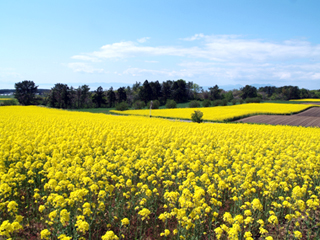
In 1989 Yokohama-machi became the town with the highest rapeseed acreage in Japan. Two years later it held its first Nanohana (Rape Blossom) Festival, an event that has continued for 18 years. The festivities, which take place in and around blossoming rape fields, include a marathon with as many as 1,000 participants and a giant maze overlooking the bay.
In the years since 1989, however, the town’s rapeseed industry has declined due to competition with cheap Canadian canola oil, a dwindling agricultural population, and other factors. As of 2007, the acreage and number of rapeseed farms had dropped to 108 hectares and 83 farms.
A New Vision for an Ancient Oil
Yellow rape fields are a familiar sight that arouses nostalgia in the Japanese mind. Rapeseed oil has been used in Japan alongside sesame oil and soy oil since shojin ryori (Buddhist vegetarian cuisine) was introduced during the Kamakura period (1185?1333). Its production surged in the Edo period (1603?1868) as Western-influenced fried foods such as tempura and ganmodoki (deep-fried tofu balls) became widely popular. The tempura stalls and oil lanterns that enlivened the streets both used domestic rapeseed oil.
Prior to World War II, 97 percent of the rapeseed oil consumed in Japan was domestically produced. But this volume quickly waned after the war as imported soy, rapeseed, and cottonseed oils inundated the cooking oil market. “Dietary education” campaigns conducted under US supervision using kitchen cars led to Westernization of the Japanese diet, and today the Japanese consume about three times more cooking oil than they did four to five decades ago.
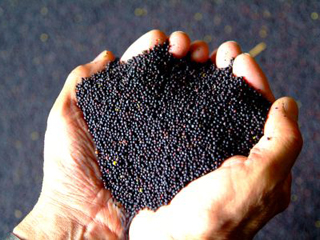
According to Yonezawa Oil of Kumagaya-shi, Saitama Prefecture, which manufactures oil from the rapeseeds grown in Yokohama-machi, imports of rapeseed from Canada and Australia came to about 2.5 million tons in 2007. The rapeseed grown in Japan, meanwhile, totaled only about 996 tons. Japan now produces only 0.05 percent of the rapeseed it consumes.
“Up until around the 1950s or 1960s, Japan still used to produce about three hundred thousand tons of rapeseed,” says Daizo Yasuda, owner of the oil wholesaler Yasuda Oil Shop in Meguro-ku, Tokyo. Yasuda, who also serves as the Tokyo branch representative of Yonezawa Oil, has actively rooted for domestic rapeseed farms. Together with consumer organizations, he petitioned the government when the influx of imports following trade liberalization came to threaten Japanese producers. The outcome was a subsidy system for domestic rapeseed and soy farms, currently continued for rapeseed producers.
In the face of this critical situation, a grassroots movement called the Nanohana Project was launched in 2001. Its origin dates back to 1976, when a project was started in Higashi-Omi-shi, Shiga Prefecture, to collect and make soap from the waste cooking oil that had been polluting Lake Biwa. The late 1990s saw the start of a new effort to cultivate rape using fallow fields, extracting oil from the seeds, and distributing the oil for use in homes and in school lunches. This soon evolved into the current Nanohana Project, which aims at realizing a grand cycle: collecting the waste oil from these homes and schools and recycling it not only as soap but also as biodiesel fuel for school buses and tractors. The project has now spread to over 100 locations across Japan.
Production of Rapeseed Oil
Rapeseed is sown in early September. Many farms in Yokohama-machi utilize chemical fertilizers, but they also add compost made from cow manure and other substances. No pesticides are used. The rape variety grown in the town is Kizakinonatane, which became a recommended cultivar of Aomori Prefecture in 1990. It is ideal for producing rapeseed oil, having a high oil content and being low on erucic acid, a substance that can have adverse effects on the heart when taken in large quantities.
The seeds sprout in about two weeks, and the plants can be overwintered in the fields. But as rape is not suitable for continuous cropping, farms in Yokohama-machi rotate it with other crops, such as potato and carrot.
With the introduction of combine harvesters for communal use in 1989, harvesting became much easier than before. Farms growing rape increased, and the town’s rapeseed acreage became number one in Japan. The oil pressed from the harvested seeds is currently sold by three organizations in Yokohama-machi.
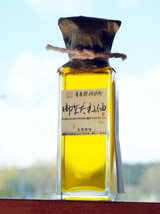
The citizen group Nanohana Trust in Yokohama-machi sells premium rapeseed oil packaged in finely crafted glass bottles. Founded in 2003, the group maintains three hectares of rape fields. In 2006, moreover, it managed to purchase oil mills in the hope that farms would continue to grow rape even after subsidies are cut off.
The Nanohana Trust began buying rapeseeds from farms on a major scale in 2008. Rapeseed farms in Yokohama-machi currently receive 12,000 yen for every 60 kilograms of rapeseed sold, including national and municipal subsidies. In 2008 the trust bought 25 kilograms for 4,500 yen, which translates to 10,800 yen per 60 kilograms. “Farmers who are just eking out a living have told us that they still want to go on growing rape, as long as it doesn’t mean losing money,” says Secretary General Keiko Miya. In 2007 the group was deluged with more orders than their supply of rapeseed could meet. It hopes to steadily increase the number of contract farms each year by making rounds of local producers.
The trust uses only first-press oil taken from unroasted rapeseed. Only 30 percent of the oil content can be extracted from unroasted seeds, whereas roasted seeds yield 40 percent, but oil produced in this way is more resistant to oxidation. The oil is heated only once. Unlike ordinary oil, which is heat sterilized at about 140 degrees Celsius, here the rapeseed oil only reaches about 70 degrees as it is pressed in the mill.
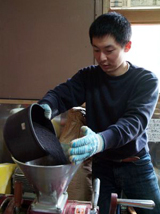
Seeds with high moisture content can jam the screw press, so the harvested seeds are sun dried in place of roasting. Only about 300 grams of oil can be extracted from a kilogram of these seeds. After filtering once, the oil is stored for several days to allow impurities that can spoil the flavor to settle. Just the upper portion is then passed through a filter three to four times to improve purity. It is the human eye that checks the oil for impurities, and the bottles are also capped by hand.
The time it takes for the mill to extract oil widely varies by temperature and humidity; it takes several times longer in the winter than in the summer. The mill needs to be warmed to about 70 degrees before pressing. If it gets jammed, the heavy machine must be disassembled and cleaned, a murderous task.
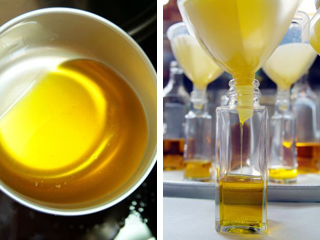
In 2008 the trust introduced O-Nataneyu, a rapeseed oil filtered six times in all. Smooth to the palate and full of zest, it makes a great match with white fish. But given the time-consuming production method, only 45 liters a day can be made at most.
JA Yokohama-machi, meanwhile, outsources oil production to Yonezawa Oil in Saitama Prefecture. Yonezawa Oil currently manufactures about 40 percent of all domestic rapeseed oil. Here, rapeseed oil is extracted and refined in the following manner.
After being sieved, the seeds are roasted under direct heat at between 115 and 120 degrees Celsius to aid oil extraction. A full, rounded aroma arises as the seeds are mashed by rollers and pressed in the mill. Thick, dark impurities are removed with the help of water: A small amount of hot water is mixed into the oil to wash away impurities, a process that is repeated six times. The oil is then deodorized by electrothermal heating, cooled, and stored in tanks. The oil cake, or the solid residue left after extraction, is marketed as fertilizer.
A Cloudy Future
Nowadays biodiesel, often made from rapeseed and canola oil, has been the focus of much ado around the world. In some countries the government funnels subsidies to the production of these oils, and farms actively grow rape. But there are concerns that genetically modified rapeseed may quickly take over if the oil is not intended for human consumption. In fact, 82 percent of the rapeseed produced in 2006 in Canada, the main exporter to Japan, was genetically engineered. Even Australia, which had been critical of GM crops, is beginning to have second thoughts due to drought and other reasons. Given the ongoing Westernization of the Chinese diet, moreover, the outlook for the distribution of cookingc oil is unclear. It is imperative that Japan augment its self-sufficiency ratio.
Domestic production of rapeseed faces another serious challenge. The national subsidies that have helped keep down the price of rapeseed oil will end in 2010. The people of Yokohama-machi predict that many farms will switch to other crops if they cannot earn a living with rapeseed. Other municipalities that have promoted rapeseed production face the same situation.
Rape blossoms and rapeseed oil are coming to hold symbolic importance for farms, citizens, and municipalities that are paving the way, if slowly, toward self-sufficiency in food. The understanding and support of consumers, as well as agricultural policy with a long-term vision, is indispensable for these efforts to become mainstream. It is time to repent the overconsumption of oil and shift from our focus from quantity to quality. ( This Article was first published on November 4, 2008 )
Photos: Hiroaki Horiguchi
